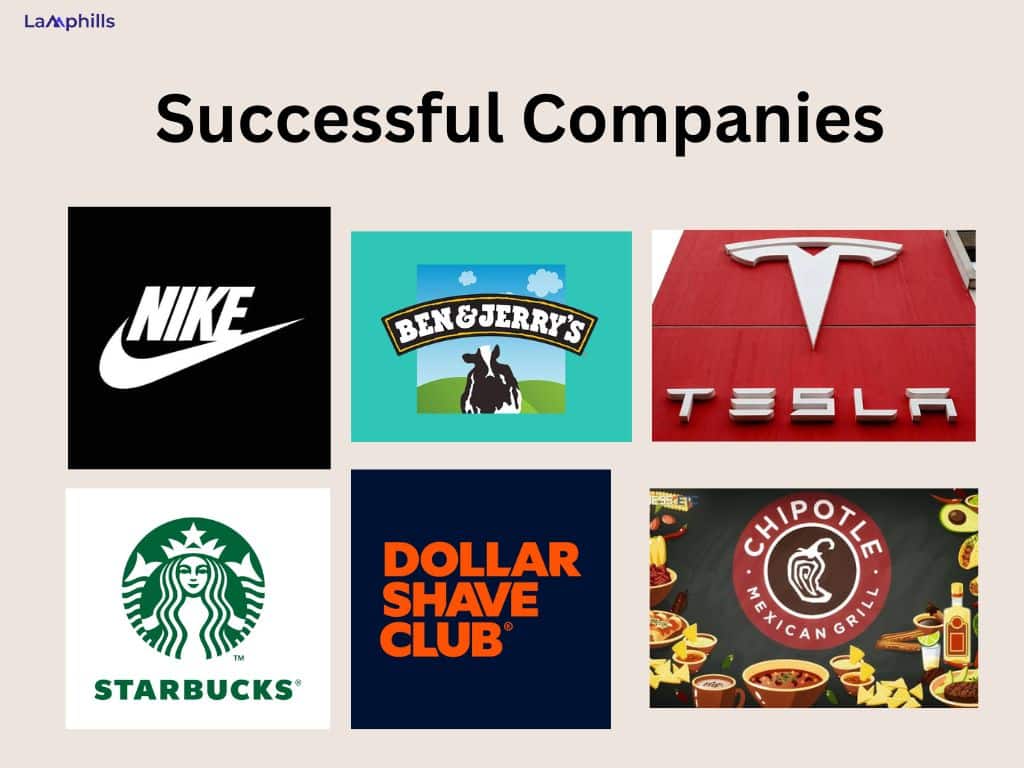Many brands explore strategies here and there, often using numerous options and opinions. It’s not easy, especially when you’re just starting up your business. The pressure to stand out in the marketplace can be overwhelming. But here’s some good news: there are successful brands out there that have the best brand strategy examples you can follow.
These companies have cracked the code when it comes to branding, demonstrating that a well-crafted strategy can lead to remarkable success. Here, I’ll share some of the best brand strategy examples from industry leaders who have captured attention and also built loyal followings. So, if you’re curious about what makes a brand truly grow, keep reading for more insights!
Key Points
- Brand strategy examples demonstrate how successful companies build strong identities that resonate deeply with their audiences and values.
- Examples include Ben & Jerry’s, Nike, Dollar Shave Club, Chipotle, Starbucks, and Tesla, showcasing unique and impactful strategies.
- Values-driven branding builds customer loyalty by connecting products to meaningful causes like sustainability, inclusion, and social responsibility.
- Multi-brand strategies allow companies to reach diverse customer segments, minimizing risks by offering a variety of products.
- Even mixed brand strategies, like Apple and Beats, combine brand strengths to attract new audiences without losing core identity.
Brand Strategy Examples from Successful Companies
If you’re looking for successful brand strategy examples to use for your business, then you’re at the right place. There are so many brands with the best strategy examples, and from my findings, here are the best that can boost your business.

#1. Ben & Jerry’s
Ben & Jerry’s is more than just a place to grab a scoop of your favorite ice cream; it’s a brand that genuinely cares about social issues. They have a strong commitment to making the world a better place, tackling important topics like climate change, racial justice, and LGBTQ+ rights.
You’ll even notice that some of their ice cream flavors have names that highlight these causes, which adds a fun twist to their mission. By engaging customers through campaigns that promote awareness, they’re not just selling ice cream but also building a community of like-minded people who appreciate their values. This way, their customers feel a real connection to the brand, creating loyalty that goes beyond just delicious treats.
#2. Nike
When I think about Nike, it’s clear that their brand strategy focuses on inspiration and empowerment. Their messaging connects with athletes of all skill levels, urging us to go beyond our limits. How iconic is the “Just Do It” slogan? It’s like a universal pep talk that encourages everyone to take that first step, no matter where they are on their fitness journey.
What I also really appreciate is how Nike embraces diversity and inclusion in their marketing campaigns. They don’t just feature the typical athlete; they highlight people from all walks of life, showcasing different backgrounds and abilities. This not only broadens their appeal but also makes people like me feel seen and inspired. Basically, it’s all about creating a community where everyone can find motivation and feel empowered to chase their dreams.
#3. Dollar Shave Club
Dollar Shave Club truly shook up the razor market, didn’t it? Their subscription model is just so clever. Instead of the usual hassle of running to the store and dealing with overpriced, flashy razor packs, they made it easy and fun to get high-quality blades delivered right to your door.
I think what really captured people, though, was their launch video. It had this perfect blend of humor and relatability that instantly connected with viewers. It wasn’t just about selling razors; it turned into a whole experience. The brand’s voice felt genuine, which probably helped them build a loyal following.
In a world where consumers are often overwhelmed by choice, Dollar Shave Club made grooming products feel more personal and approachable. Therefore, I must say it’s a great example of how a great idea, combined with quirky marketing, can create a community and disrupt an entire industry. What do you think? Explore this Dollar Shave Club brand strategy example and watch out for its positive results!
#4. Chipotle
I appreciate Chipotle’s brand strategy because it focuses heavily on quality and sustainability. As someone who cares about what I eat, I find it refreshing that they emphasize using fresh, responsibly sourced ingredients. It makes me feel good about my choices when I know that the food I’m enjoying comes from a conscientious place.
Another thing is how Chipotle actively engages with its customers. They talk about their mission to create a better food culture and show transparency in their sourcing and food preparation. Amazing, isn’t it?
This isn’t just about selling food; it feels like they genuinely want to make a difference in the way we consume food. Also, their marketing shows the importance of ethical food consumption, which keeps me coming back. It’s nice to feel like my dining choices can align with my values. So, if you’re still looking for successful brand strategy examples, check out Chipotle!
#5. Starbucks—Brand Vision
Starbucks isn’t just about coffee; it’s all about creating a unique experience for its customers. Their vision goes beyond serving up a delicious cup of java. They focus on building a sense of community and promoting sustainability, which resonates with many people today. Now, tell me, when you walk into a Starbucks, isn’t the vibe inviting and cozy, almost like a second living room? Of course, I know you enjoy every moment at Starbucks.
Also, they’ve nailed personalization—through their loyalty programs, every customer feels appreciated and recognized. It’s not just a transaction; it’s about making connections and feeling like part of something bigger. So, when you sit down with your favorite drink, you’re not just sipping coffee; you’re part of the Starbucks experience that champions comfort and community.
#6. Tesla
Tesla’s branding strategy focuses on two key ideas: innovation and sustainability. They’ve managed to draw out a unique spot in the market as a leader in electric vehicles. I mean not just selling cars, but promoting a lifestyle that emphasizes advanced technology and caring for the environment. This aspirational image attracts many people who want to feel part of a movement towards a greener future.
Also, I see how Tesla has fostered a loyal community of supporters. Instead of relying heavily on traditional advertising, they use the enthusiasm of their customers and the outspoken nature of CEO Elon Musk to generate buzz. Who hasn’t been moved by the way Elon Musk speaks? His charismatic personality further amplifies that conversation around the brand.
Hence, this word-of-mouth marketing effectively turns Tesla owners into brand ambassadors. That’s creating an engaging narrative that attracts even more attention to their products.
Multi Brand Strategy Examples
A multi-brand strategy is all about a company owning and managing several brands under one umbrella, which allows them to cater to different market segments and consumer preferences.
Take Nestlé, for example. They have an incredible portfolio of over 2000 brands. This means they can appeal to many customers with products like Nespresso for coffee lovers and the beloved KitKat for chocolate fans. This diversity not only enhances their market reach but also minimizes risks, as they are not relying on a single product.
Even L’Oréal, a giant in the beauty industry, isn’t left out when it comes to multi brand strategy examples. They own well-known brands like Garnier for affordable skincare, Maybelline for trendy cosmetics, NYX for those who love bold looks, and La Roche-Posay for sensitive skin enthusiasts. This multi-brand approach enables them to serve many tastes and preferences in the cosmetics and skincare market. I have sensitive skin and L’Oréal’s marketing strategy has made me fall in love with La Roche-Posay products, especially their sunscreen.
Inditex, the parent company of brands like Massimo Dutti, Pull&Bear, and Oysho, also exemplifies this strategy. Each brand has its own distinct style and target audience, from chic, sophisticated fashion to casual, trendy looks. This versatility allows Inditex to capture a broad spectrum of fashion lovers.
Read this: Umbrella Branding Explained: Successful Examples and Key Strategies
Mixed Brand Strategy Examples
A mixed brand strategy combines elements from different branding approaches. This can create a versatile and appealing image for various customer segments. I know you might be wondering how mixed brand strategy works, well here are some examples:
#1. Apple and Beats: When Apple acquired Beats by Dre, it didn’t just add a new product line—it created a mixed brand dynamic. You’ll agree with me that Apple’s sleek, tech-savvy image was enhanced by Beats’ edgy hip vibe. Therefore, by merging premium quality with music culture, they successfully attracted a broader audience without diluting their own brand identity.
#2. Starbucks and Teavana: Starbucks is primarily known for its coffee, but when it introduced Teavana, it didn’t just slap its brand on a tea line. Instead, they integrated the sophisticated tea experience with their existing coffee culture. I mean inviting tea lovers to enjoy an upscale product within a familiar and cozy environment. Hence, this strategy expanded their market while maintaining brand loyalty.
#3. Coca-Cola and Fanta: Coca-Cola has a mixed brand strategy in its family of beverages, where it offers multiple products under the Coca-Cola brand. Fanta, for instance, targets a younger audience with its fruity flavors and vibrant marketing. It uses Coca-Cola’s strong brand recognition while allowing itself to stand out with its unique personality, appealing to diverse consumer preferences.
Ready to build a standout brand? Download this power-packed checklist for writing a consistent, unforgettable brand identity!
How to Apply Brand Strategy Insights to Your Business
What Are The Four 4 Types Of Branding Strategies?
When it comes to branding strategies, there are four main types that companies often explore. The first one is line extension, which involves adding new products to an existing brand, like a new flavor of a popular snack.
Then, brand extension, where a brand leverages its reputation to launch a completely different product. Just think of a clothing line from a well-known shoe company.
Next is multi-brands. This is where a company creates separate brands within the same category to capture more market share. For example, a parent company offering different personal care lines.
Lastly, there’s the creation of new brands. This is all about starting fresh, and developing a brand from the ground up to cater to a new audience or market. Each of these strategies allows businesses to adapt and grow in unique ways.
What Are Three Common Brand Strategies?
Three common brand strategies are brand positioning, brand extension, and co-branding.
Brand positioning involves defining how you want consumers to perceive your brand over the competitors. It often focuses on unique attributes.
Brand extension allows companies to leverage their existing brand equity by introducing new products under the same name. For example, Apple moved from computers to smartphones.
Then, there’s co-branding, where two brands collaborate to create something fresh and exciting. Just see it as when you see a popular snack team up with a beverage brand. With these strategies, your brand can stand out and connect with customers in meaningful ways.
What Are The 4 Cs Of Brand Strategy?
The 4 Cs of brand strategy are a fantastic framework for building a brand that genuinely resonates. First is the company, which is all about understanding your organization’s values and goals. Then category, focusing on the market you’re in and how your brand fits in with others.
Next is the consumer, where you dive deep into who your audience is and what they truly want. Finally, culture, which looks at the social and cultural context that influences your brand.
Together, these elements create a solid foundation for your brand. It’ll not only stand out but also connect with people on multiple levels.
How Do You Do Brand Strategy?
To develop a brand strategy, I start by clearly defining the brand’s purpose and values. I think about who my target audience is and what they need or desire. Then, I analyze the competition to find my unique positioning in the market.
Next, I write a compelling brand story that will attract my audience. That ensures consistency across all touchpoints. That’s not all! I also set specific goals and metrics to track progress.
Finally, I regularly revisit and adjust my strategy as needed to stay relevant and effective. So, with all these, I must say that I built a strong, authentic connection with my clients, which I believe is the heart of a successful brand strategy.
What Is The Best Branding Strategy?
When I think about the best branding strategy, I believe it comes down to authenticity and consistency. For example, when I started my online business, I focused on sharing my personal story and values.
This genuine connection helped me draw my audience. I made sure that every piece of content, from my website to social media posts, reflected that same message. Over time, this consistency built trust and recognition among my customers, ultimately leading to a loyal following.
So, in my experience, being true to yourself while maintaining a cohesive brand presence works wonders.
Related Articles
Brand Messaging: Examples to Inspire Your Business Strategy
15 Famous Brand Positioning Examples to Inspire Your Brand Strategy (+ Branding Tips)
16 Compelling Brand Video Examples and 10 Tips for Creating One
Exploring the Branded House Strategy + Key Examples






